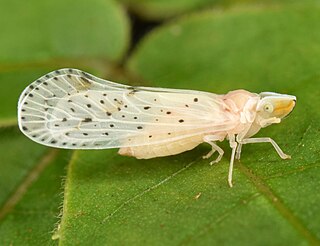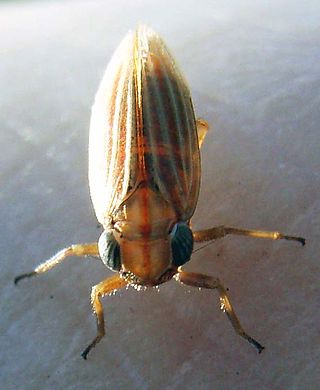
The Cixiidae are a family of fulgoroid insects, one of many families commonly known as planthoppers, distributed worldwide and comprising more than 2,000 species from over 150 genera.

Delphacidae is a family of planthoppers containing about 2000 species, distributed worldwide. Delphacids are separated from other "hoppers" by the prominent spur on the tibia of the hindleg.

The family Derbidae is a large and diverse group of planthoppers, widely distributed in the tropics and also found in subtropical and temperate regions. It includes more than 150 genera and more than 1500 species. The adults suck the sap of plants while the nymphs live mainly in decaying organic matter, for example under the bark of dead tree trunks, feeding on fungi. In some groups of species the general structure of the insects is largely uniform, whereas in others like in the subfamily Otiocerinae various forms can be found. For example, the shape of the head, the antennae or the wings can differ considerably among genera and species.

Dictyopharidae is a family of planthoppers, related to the Fulgoridae. The family comprises nearly 760 species in more than 150 genera which are grouped into two subfamilies, Dictyopharinae and Orgeriinae.

Opsiini is a tribe of leafhoppers in the subfamily Deltocephalinae. The tribe contains 36 genera and over 300 species divided into four subtribes: Achaeticina, Circuliferina, Eremophlepsiina, and Opsiina.

Caliscelidae is a family of planthoppers, sap-sucking insects that belong to the order Hemiptera, suborder Auchenorrhyncha and superfamily Fulgoroidea. They are somewhat anomalous and have often been included within the family Issidae. Studies made in 2013 of the phylogeny of the Issidae and other groups using molecular techniques support the treatment of the group as a separate family. Sexual dimorphism can be marked. Some members of the family are called piglet bugs due to the shape of their snout. A particularly aberrant genus described in 2011 from India, Formiscurra, has males that resemble ants.

Cixiinae is a planthopper subfamily in the family Cixiidae. It is one of three such subfamilies, the other two being the Bothriocerinae and the Borystheninae. While a few species had been tested in a larger study of the Fulgoroidea, neither the Cixiinae nor its tribes were analysed cladistically until 2002. Resolution of tribal relationships is incomplete and additional testing of the tribes with samples larger than one per tribe is needed.

Oecleini is a tribe of planthoppers in the subfamily Cixiinae.

Lophopidae is a family of fulgoroid plant-hoppers with most species found in tropical South America and Asia.

Cixius is planthopper genus in the tribe Cixiini.

Cixiini is a planthopper tribe in the family Cixiidae. This tribe is non-monophyletic.

Achilidae is a family of planthoppers, sometimes called "achilids" in the order Hemiptera. There are at least 520 described species in Achilidae.

Dictyopharinae is a subfamily of dictyopharid planthoppers in the family Dictyopharidae. There more than 100 genera and 500 described species in Dictyopharinae.

Meenoplidae is a family of fulgoromorph planthoppers that are closely related to the Kinnaridae. They are small, with tent-like wings and usually are less than a centimetre long and a little more than a 100 species in around 25 genera are known with a distribution restricted to the Old World. They are distinguished by having one or more of their claval veins covered in sensory pits along their length. The face is usually broad and the lateral carinae are strongly elevated. The last segment of the labium is elongate. A median ocellus is usually present. The wings are always present in adults and the venation consists of a small number of veins and very few cross veins. There are two subfamilies currently considered valid Meenoplinae and Kermesiinae. About 50 species are known from Africa. Along with the Achilixiidae and Kinnaridae, they have flattened star-shaped plate organs on their antennae. The nymphs are found close to the soil while adults feed mainly on monocots. Species identity can usually be established reliably only by examination of the male genitalia. A few species Phaconeura pluto, Meenoplus cancavus, Tsingya clarkei, and Suva oloimoa are known to be cave dwelling.
The Gengidae are a family of Fulgoromorpha (planthoppers), with species found in South Africa.
Paralimnini is a tribe of leafhoppers in the subfamily Deltocephalinae. Paralimnini contains 139 genera and over 900 species divided into two subtribes: Aglenina and Paralimnina. The tribe has a cosmopolitan distribution.

Psammotettix is a genus of true bugs belonging to the family Cicadellidae. The species of this genus are found in Eurasia and North America
Swainsona plagiotropis, commonly known as red swainsona-pea is a species of flowering plant in the family Fabaceae and is endemic to eastern continental Australia. It is a prostrate or ascending perennial herb with imparipinnate leaves with 13 to 25 narrowly egg-shaped or narrowly lance-shaped leaflets and racemes of 2 to 5 reddish-purple flowers.












